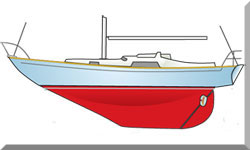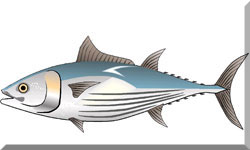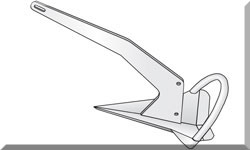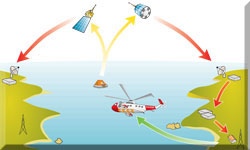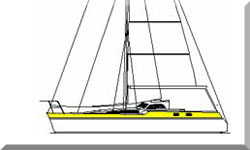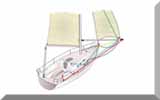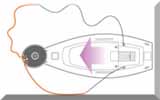- Home
- Design
- Wood Epoxy Boat Design
- Boat Toilet Maintenance
Offshore Boat Toilet Maintenance & Critical Head Systems
In a Nutshell...
Boat toilet maintenance is arguably one of the most vital, yet often overlooked, parts of yacht ownership. The core takeaway? Regular, proper flushing and preventative care are non-negotiable for marine sanitation systems. Whether you’re running a classic manually-pumped head or a modern 12v macerator unit, failing to clear the entire discharge hose length after every single use will lead to mineral build-up (furring) from saltwater, causing blockages, leaks, and inevitable, truly unpleasant smells. For maximum reliability offshore, anti-siphon valves are absolutely essential, and sailors should be acutely aware of regional waste discharge laws and holding tank requirements. Don't skimp on quality—marine-grade hose and double-clipped connections are your best insurance against a rotten day at sea.
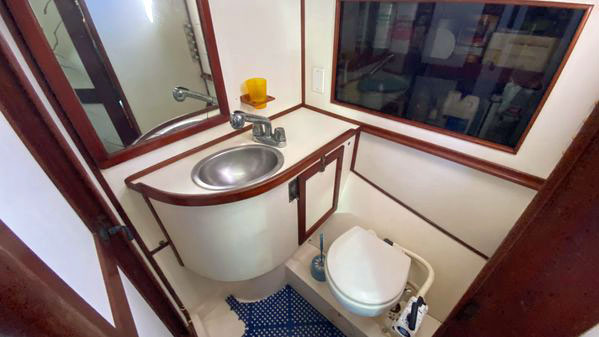 The Head
The HeadTable of Contents
- Understanding the Common Marine Head Systems
- Holding Tanks & Waste Discharge Regulations
- Through-Hull & Seacock Management: The Ultimate Safety Check
- Keeping the System Working: The Art of the Flush
- Odour Control: Beyond the Flush
- Essential Marine Head Troubleshooting: A Quick Fix Guide
- Summing Up
- Frequently Asked Questions (FAQs)
The Ins & Outs of Boat Toilet Maintenance & Systems
As an experienced ocean sailor, I can tell you that a functioning head is the difference between a comfortable passage and a nightmare cruise. My first proper cruising yacht, a venerable Nicholson 32, taught me a lot about reliability, mostly thanks to its no-nonsense Lavac boat toilet. It was efficient and reliable, using a vacuum created by the pump to suck out the contents—though you did have to remember to keep the lid shut during the process. That lingering vacuum, firmly holding the lid down for a while afterwards, was a minor irritation when there was a queue, but it was a small price to pay for a system you could trust.
Traditionally, we call it ‘the heads’ owing to its forward position in older vessels. But whether you call it a head, a loo, or a boat toilet, these pump-operated systems can be temperamental if they aren’t properly cared for. A smelly cabin, a leak, a blocked pump, or furred-up pipes are all classic signs of neglect. All of these unhappy events can be entirely prevented by correct installation and, crucially, a regime of regular maintenance.
Let’s take a look at the common types of boat toilet systems you’re likely to encounter offshore, and what it takes to keep them in top shape.
Understanding the Common Marine Head Systems
The Manually Pumped Sea Toilet
This is the tried-and-tested workhorse of marine sanitation. Its malicious streak, however, can come to a head (sorry) when it’s installed below the waterline. This is where things get serious: a siphon effect can be induced, flooding and eventually sinking your boat if the proper safety measures aren’t in place.
 A manual sea toilet installation
A manual sea toilet installationFor any toilet installed below the waterline, or one which becomes submerged when the boat is heavily heeled, pumping water in (and waste water out) can start a runaway siphon. Anti-Siphon Valves are absolutely essential on both inlet and outlet pipes to break this vacuum. Don't skip this step—your boat’s buoyancy depends on it.
A few installation tips from the coal face:
- Hose Matters: Always use Marine Sanitation Grade hose for all discharge pipework. Standard plumbing hose will let the dreaded ‘pumps a smell’ gas permeate through its walls, guaranteeing an unpleasant cabin.
- Double-Clip Everything: Use double clips on all pipework connections. This gives you peace of mind and is a professional finish to prevent leaks, which will definitely smell and potentially sink your boat.
The 12v Electric Macerator Sea Toilet
The electric option is for those with electrical power to spare and a desire to spare their right arm. With a push of a button, the system is taken care of by your boat’s batteries.
One 12v pump sucks the flush water in, and another delivers the waste either directly into the sea (where legal) or to a holding tank. The key difference here is the incorporated macerator. Much like a culinary blender (but forget any thoughts of dual use), it quickly reduces waste and toilet paper to liquid form before pumping. This makes dealing with long discharge runs or pumping into a high holding tank much easier.
You’ve got a choice of seawater or freshwater flush versions. If you choose the latter, you’ll need a watermaker of prodigious output, as you’re flushing precious drinking water overboard.
Portable & Permanent Marine Toilet Systems
These are fully self-contained units, often referred to as chemical toilets. Installation is as simple as finding a secure place to put them—no complex plumbing or through-hulls are needed.
The design is straightforward: waste falls by gravity into a detachable tank beneath the bowl, which is periodically taken ashore and emptied. Typically holding between 9 and 22 litres (2 to 5 gallons), these are highly suitable for small sailboats or as an acceptable, odour-free alternative to a fixed holding tank installation, particularly in coastal areas with strict discharge laws.
Holding Tanks & Waste Discharge Regulations
For any offshore or coastal cruising, understanding and complying with waste discharge regulations is non-negotiable. Many popular cruising grounds, including the entire Baltic Sea, the US Great Lakes, and many European harbours, are designated as No Discharge Zones (NDZs). This means you must have a functional holding tank, and your toilet system must be capable of routing waste into it rather than directly overboard.
Holding tanks store black water (toilet waste) until it can be legally pumped out ashore at a designated pump-out station.
 Sea water toilet with holding tank
Sea water toilet with holding tankKey Considerations for Holding Tanks:
Capacity: Ensure the tank capacity is appropriate for your crew size and intended cruising duration. For extended voyages, a larger tank minimises the need for frequent pump-outs or risky offshore discharges.
Ventilation: Proper ventilation is vital. If the tank can’t breathe, pressure builds up and the anaerobic bacterial action inside generates that awful hydrogen sulphide gas, making the whole boat smell. A quality vent filter can absorb these odours.
System Bypass: The system should have a clearly labelled Y-valve that allows the skipper to select whether waste goes overboard (when legal and offshore) or into the holding tank. The valve for overboard discharge must be secured (or locked) in the closed position when in an NDZ.
Monitoring: Investing in a reliable holding tank level sensor prevents overfilling, which is a truly disgusting clean-up job no sailor wants.
On the Water...
Retro-fitting a rigid plastic marine holding tank is likely to test the ingenuity of most boat owners, who will already have claimed all suitable spaces for other useful purposes.
A flexible holding tank may provide a solution, although if it chafes through it will provide rather more...
Through-Hull & Seacock Management: The Ultimate Safety Check
While the plumbing inside your boat is vital, the point where the sanitation system interfaces with the hull—the through-hull fitting and its accompanying seacock—is where the greatest risk of sinking lies. An experienced sailor knows these fittings aren't just accessories; they’re non-negotiable safety components.
The Golden Rule of Seacocks
For any through-hull below the waterline, the golden rule is simple: Always close the seacock when the system isn't actively being used or when you are leaving the vessel unattended. A failing hose clamp, a split pipe, or a pump malfunction can turn a minor inconvenience into a disaster in minutes if the seacock is open.A quality marine seacock is designed to shut off the flow of water into the vessel completely. It should operate smoothly and easily—if it feels stiff, it needs maintenance or replacement immediately. The material, installation, and operation of these fittings are fundamental to the safety and structural integrity of the yacht, and were a key consideration when we built our wood-epoxy cutter 'Alacazam'.
Material Selection & Maintenance
For offshore vessels, the choice of material is key. You’ll typically encounter three types:
| Material | Pros & Cons | Maintenance Notes |
|---|---|---|
| Bronze | Highly durable & strong; excellent corrosion resistance. | Requires periodic lubrication to ensure smooth operation. The standard for safety. |
| DZR Brass | Cheaper than bronze, but susceptible to dezincification in saltwater. | Avoid on hull fittings below the waterline for blue water sailing. |
| Composite (e.g., Marelon) | Lightweight, non-corrosive, & non-conductive (avoids electrolysis). | Must be installed correctly to avoid overtightening; inspect for UV degradation over time. |
Regardless of the material, you must cycle your seacocks regularly—at least once a month—to prevent them from seizing open or closed. It's a quick job that prevents a massive headache later. Also, remember to inspect the exterior of the through-hull for marine growth (barnacles, mussels), which can severely restrict water flow and strain your pump.
Keeping the System Working: The Art of the Flush
The unpleasant stuff found in clogged hoses is a calcium deposit, the inevitable result of mixing uric acid with the salt and calcium carbonate present in saltwater. This phenomenon, known as furring, is the number one cause of marine toilet failure.
This can be dramatically reduced by making sure you properly flush the toilet on every single use.
The Magic Number of Pumps
It’s not enough to stop pumping just as soon as the toilet bowl is clear of our bodily waste products—you’ve got to keep going until the last of the contents exits the through-hull fitting. If you don’t, traces of that mixture will be left in the pipe, the pump, or the macerator, where sooner or later it’ll ruin your day.
The critical question is: How long should I keep pumping?
The answer depends entirely on the length of your discharge hose. The solution is simple and involves a one-off calibration:
- Put a few sheets of toilet paper in the bowl, start pumping, and count the strokes.
- Get another person to check when the paper emerges at the through-hull fitting on the outside of the boat.
- Add another half-a-dozen strokes or so to that count. That is your ‘magic number’—the minimum number of times you must pump it on every use.
- If your system has a ‘dry’ setting, click the switch across and pump a few more strokes to empty the pipes down to the waterline, preventing freezing and residual smells.
Why Choose a Freshwater Flush?
With all that seawater available, it might seem strange to use your precious freshwater to flush your loo. However, the reason is purely preventative maintenance: freshwater doesn’t contain the salt and calcium minerals found in seawater, so the corrosive furring described above just doesn’t happen.
Another huge benefit is that the characteristic ‘rotten-egg smell’ (hydrogen sulphide gas) associated with saltwater toilets, caused by the decomposition of marine life in the pipes, is entirely eliminated too.
But here’s the big issue for a cruising sailor: how do you ensure that no cross-contamination can occur between the freshwater flushing the toilet and the drinking water in your tanks?
One sensible, albeit manual, approach I’ve seen is a skipper who uses his boat’s shower head to fill the toilet bowl while flushing—a clean, external method that avoids plumbing risk. Others might use a diverted line from the galley sink.
For a fully plumbed-in, safe freshwater flush system, you must ensure a proper anti-siphon loop (well above the waterline) or use a dedicated anti-siphon solenoid valve, such as the one Jabsco produces for their 12v electric toilets. This hardware goes a long way towards guaranteeing isolation, but you can never be too careful when it comes to potable water.
Odour Control: Beyond the Flush
The relentless fight against malodour is central to good boat toilet maintenance. While a proper flush is the first defence, there are sophisticated measures required for complete peace of mind, especially when dealing with a holding tank.
Dealing with Hose Permeation
I can’t stress this enough: standard PVC hose will absorb waste odours over time. The gas from the decomposition process permeates the material, and eventually, your boat smells even when the system is perfectly clean. If your hoses are old, black, and smelling faintly (or strongly!) when dry, they are permeated. There is no cure; they must be replaced with specialist Marine Sanitation Grade hose.
When replacing them, ensure the run is as short and straight as possible, avoiding dips or low spots where water and waste can settle and stagnate.
The Ventilation Filter is Essential
If you have a holding tank, a vent filter is absolutely essential. The anaerobic bacteria in the tank generate hydrogen sulphide gas, which must exit the boat, but it certainly shouldn’t smell out the cockpit or deck.
- Function: These units contain activated carbon that neutralises the odorous gases before they exit the vent through-hull.
- Maintenance: These filters have a lifespan, typically 1 to 2 years, depending on use. They stop working effectively once the carbon is saturated, so they must be replaced on a schedule.
Biological Treatments & Holding Tanks
For holding tanks, the choice between treatment types is vital:
| Treatment Type | Mechanism | Effect on Tank & Odour |
|---|---|---|
| Biological (Enzyme) | Uses beneficial bacteria & enzymes to naturally break down waste & paper. | Highly effective at odour control; preserves healthy bacterial balance in the tank. **Recommended.** |
| Chemical (Harsh) | Uses strong chemicals (e.g., formaldehyde) to sterilise and kill bacteria. | Can kill beneficial bacteria needed for long-term odour breakdown; can damage seals and contribute to pollution. |
For long-term cruising and environmental compliance, biological enzyme treatments are the clear winner. They assist nature rather than fighting it, leading to a much cleaner, less volatile, and virtually smell-free holding tank system.
Essential Marine Head Troubleshooting: A Quick Fix Guide
When the head stops working, it's rarely a good time. Here is a quick reference for the most common faults and the steps an experienced sailor should take to diagnose and fix the issue.
| Problem | Likely Cause(s) | Immediate Action & Fix |
|---|---|---|
| Pump is Stiff or Hard to Operate | Piston seal/O-ring is dry; furring (mineral deposit) build-up inside the pump body. | Action: Close seacock. Pour warm vinegar or specialised cleaner into the bowl and pump it through. If no improvement, it needs a service kit (new seals/o-rings). |
| Water Won't Pump In (Dry Bowl) | Blocked inlet seacock or through-hull fitting (marine growth). | Action: Close inlet seacock. Briefly poke the inlet hole from outside (if hauled out) or attempt to carefully clear the hose leading from the seacock with a flexible rod (after isolating the pump). Ensure the inlet seacock is open. |
| Water Won't Pump Out (Full Bowl) | Blockage in the discharge hose, pump, or macerator. | Action: Close seacock. If manual, check the joker valve for obstruction (the most common fault). If electric, check the macerator for power/jamming. Do not force the pump. Disassembly may be required. |
| Continuous Slow Leak Into Bowl | Faulty or worn joker valve. | Action: The joker valve is a non-return valve inside the pump unit. It's designed to prevent back-flow. Close seacock, disassemble the pump discharge end, and replace the joker valve (it's part of the service kit). |
Note: Always ensure the seacock is closed before attempting any disassembly or troubleshooting on components below the waterline.
Summing Up
The head is the heart of your sanitation system, and its reliable operation hinges on consistent, diligent practice. A little effort goes a long way. Use the correct marine-grade materials, install those critical anti-siphon loops, and religiously adhere to your ‘magic number’ of pump strokes to ensure a clean discharge run. For the cruising sailor, understanding the distinction between manual, electric, and portable systems—and crucially, knowing when to switch to your holding tank—is what truly defines a prepared and responsible yacht owner. Trust me, spending a few minutes on boat toilet maintenance is infinitely preferable to spending hours elbow-deep in a blocked pipe miles from anywhere.
This article was written by Dick McClary, RYA Yachtmaster and author of the RYA publications 'Offshore Sailing' and 'Fishing Afloat', member of The Yachting Journalists Association (YJA), and erstwhile member of the Ocean Cruising Club (OCC).
Frequently Asked Questions (FAQs)
What causes that persistent 'rotten egg' smell in my marine head?
What causes that persistent 'rotten egg' smell in my marine head?
The ‘rotten egg’ smell is hydrogen sulphide gas, caused by stagnant saltwater decomposing in the inlet or discharge hoses. The salt and calcium react with waste, especially if the system isn’t flushed properly. Switching to a freshwater flush system or regularly flushing with a dedicated hose-cleaning solution can eliminate this.
Are chemical treatments necessary for a boat toilet?
Are chemical treatments necessary for a boat toilet?
While chemicals can help break down waste, many traditional, harsh chemicals can actually damage rubber seals, macerator blades, and the healthy bacteria in holding tanks. Biological treatments are generally safer and more effective for long-term use. The best preventative measure is mechanical: ensuring the system is fully flushed with clean water after every use.
How often should I replace my discharge hoses?
How often should I replace my discharge hoses?
Even the best marine sanitation hose will eventually permeate odour, especially with heavy saltwater use. As a rule of thumb, if you start smelling the waste through the hose, it’s time for replacement. For heavily used saltwater systems, this can be as often as every five to ten years.
What is the correct procedure for winterising a marine toilet?
What is the correct procedure for winterising a marine toilet?
First, ensure the bowl is clear. Then, shut off the seawater inlet through-hull. Pump a non-toxic, propylene glycol-based antifreeze solution through the system (not automotive antifreeze, which is toxic). Pump until the coloured solution emerges from the through-hull outlet. This prevents freezing damage to the pump, bowl, and hoses.
Can I use regular toilet paper in a marine head?
Can I use regular toilet paper in a marine head?
It's best to use dedicated marine toilet paper or paper marked as 'septic-safe'. Standard household paper is often too thick to break down quickly, leading to blockages in the pump and especially the macerator or discharge pipework. A quick test is to put a sheet in a jar of water and shake it—if it breaks apart easily, it’s suitable for marine use.
What is the minimum requirement for a toilet installed below the waterline?
What is the minimum requirement for a toilet installed below the waterline?
The absolute minimum requirement for any below-waterline installation is a robust seacock on the inlet and outlet, and a correctly installed anti-siphon loop (or vented anti-siphon valve) that rises well above the static and heeled waterline. Failure to include these features is a significant sinking risk.
Recent Articles
-
Essential Boat Toilet Maintenance & Systems: A Sailor’s Guide
Nov 24, 25 01:17 PM
Master boat toilet maintenance, from manual sea heads to 12v electric systems. Get an experienced offshore sailor’s guide on avoiding clogs, leaks, & bad smells. -
Beneteau Oceanis 36CC: Specs, Ratios & Cruising Suitability
Nov 21, 25 06:26 PM
Detailed analysis of the Beneteau Oceanis 36CC centre cockpit sailboat. Includes design ratios, full specifications, and practical assessment of its suitability for experienced offshore and liveaboard… -
Mastering Offshore Seamanship: Heavy Weather & Safety Protocols
Nov 15, 25 05:00 PM
Expert guide to offshore safety and crew protocols. Master heavy weather tactics, self-steering redundancy, watchkeeping systems & essential personal safety gear.


